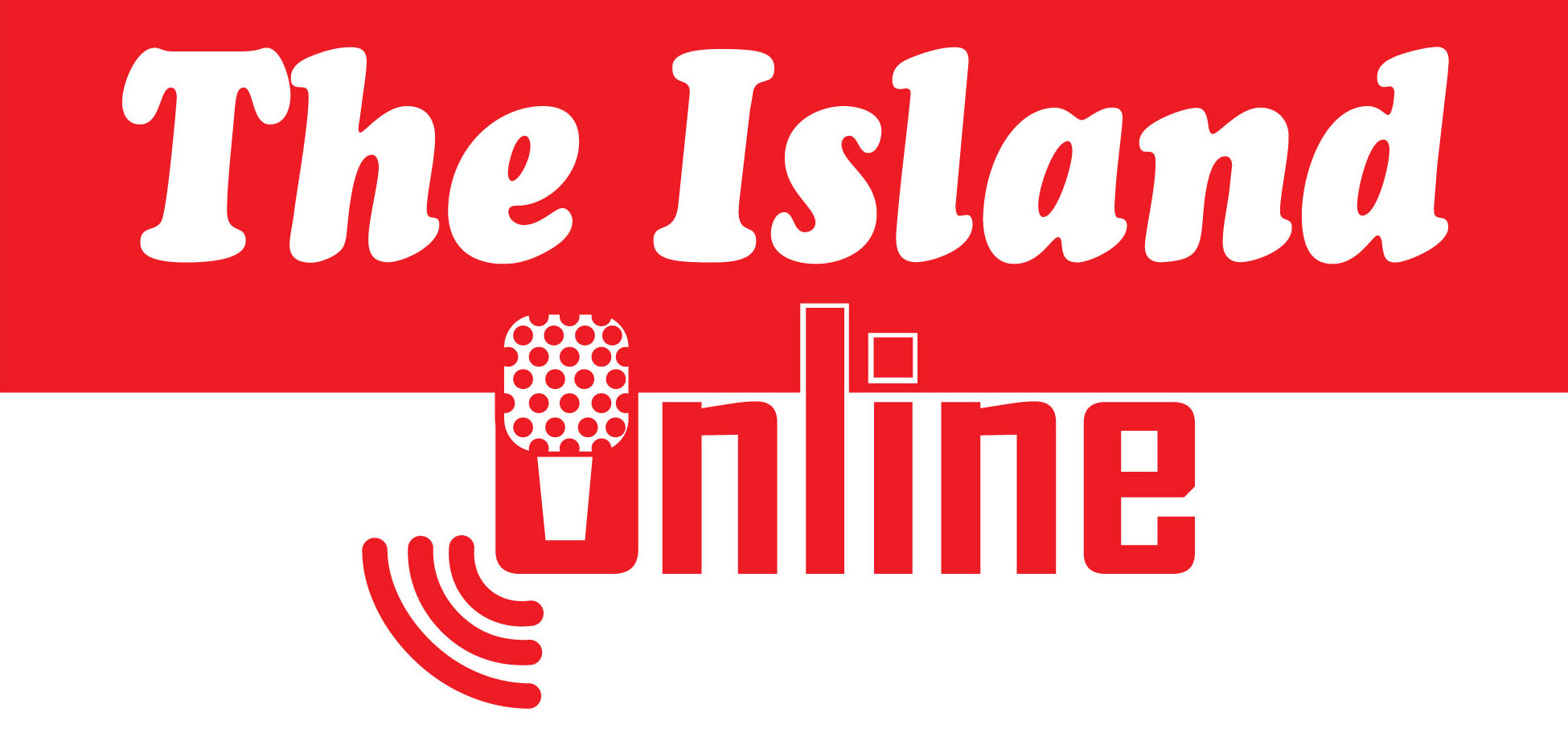Features
OPERATING SEVEN HOTELS – Part 44
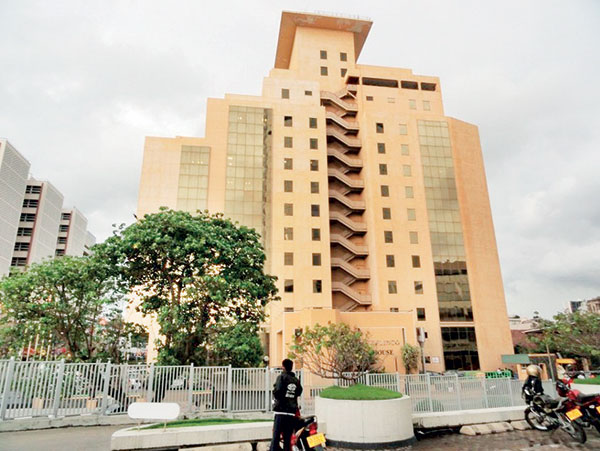
CONFESSIONS OF A GLOBAL GYPSY
By Dr. Chandana (Chandi) Jayawardena DPhil
President – Chandi J. Associates Inc. Consulting, Canada
Founder & Administrator – Global Hospitality Forum
chandij@sympatico.ca
At the beginning of 1981, I was transferred to the John Keells corporate office in Colombo. I was proud to get this opportunity to work within the largest group of companies in Sri Lanka. I had been promoted from my previous post of Manager, Hotel Swanee to number two of Keells’ hotel company, Hotel Management & Marketing Services Limited (HMMS). My wife and I quickly settled in well into the Colombo social life style with regular trips to Keells hotels on the weekends. I also re-commenced judo at the Central YMCA. Having stopped judo for six years to focus on building my career as a resort hotelier on the south coast, I was happy to get an opportunity to practice judo, and study for judo grade promotion tests once again, whenever my busy work schedule allowed me to do so.
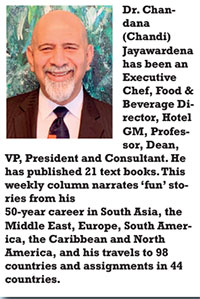
It was a big adjustment to get used to the corporate culture of John Keells which was very different to the living in and working at resort hotels. Since the nationalization of tea plantations by the socialist government in the early 1970s, John Keells commenced diversifying to multiple industries, including tourism and hospitality. In 1981, some 33 years after Ceylon/Sri Lanka gained independence from British colonizers, John Keells was still headed by two Brits (Chairman Mark Bostock and Deputy Chairman David Blackler). Nevertheless, I liked the atmosphere at the head office as John Keells had a unique and dynamic culture. It faced the historic Beira Lake built by the Portuguese colonizers in the 16th century to prevent Colombo from being re-captured by Sinhala kings and their armies.
John Keells Corporate Office in 1981
Having associated with the group’s chairman since 1972, initially through rugby football and then as a hotel manager, I was an admirer of Mark Bostock. I was extremely grateful to him for fully sponsoring my first, overseas trip and training in London in 1979. My personal friendship with him continued in 1984 when my family was invited to visit his family in their home in Royal Tunbridge Wells, Kent for an overnight stay during my graduate student years in the United Kingdom. Later in 1985, he supported the re-hiring of me to John Keells to manage their two largest hotels (The Lodge and The Village) as the General Manager.
Mark Bostock, was a great visionary leader but a little eccentric. All the executives came to work in our company cars dressed in shirt and tie, but our chairman took pride in coming to work on a scooter from his home in Colombo seven. His usual attire was a white shirt, no tie, white shorts and long white stockings, exactly the way he dressed for work during his early career as a tea planter. He enjoyed a good drink. One day at an office party, his wife was annoyed that he had a couple of extra drinks. She stopped addressing him as ‘Mark’ and said to him, “Bostock, time to go home. I will drive!” They left immediately. She was a very proper English lady and they made a good couple. I also knew their daughter Clair who was studying hotel management in the United Kingdom.
In addition to the directors, senior executives, executives and secretaries, there were office aides who served us excellent tea regularly. They also brought us our mail and office memos. During this pre internet and email era, we depended on them to have speedy inter office communications. One of the earliest memories at the corporate office that I fondly remember is how Mark Bostock often distributed memos from the Chairman’s office personally. “How are you settling in the head office, Chandana?” he asked me in my first week during one of his visits to my office. “Here are some memos for you”. He handed over a few papers to me and left very quickly. It was his clever way of getting some exercise while checking different offices and engaging in a causal conversation with all levels of his vast growing team.
At that time, most of the directors in the top of the group hierarchy were tea specialists or chartered accountants. They usually hired male management trainees with a middle-class English-speaking upbringing and from good schools. Most of those trainees had excelled in sports. These trainees were in their late teens and had no post-secondary education. John Keells tended to hire the attitude and train the skills. Those who learnt the ropes quickly and were dynamic, rose rapidly in the corporate ladder to board positions with impressive stock options. Once they got in, hardly anyone thought of leaving John Keells. They played a “long stay ball game” which provided job security, fun and great career prospects. They also had to play corporate politics and watch carefully where the wind is blowing.
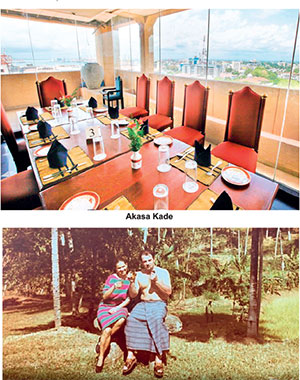
In 1981, we knew that ‘charismatic’ Ken Balendra was destined to become the first Sri Lankan chairman of the group within a few years. Since he had such a good relationship with the two Brits at the helm, some of us in a light-hearted manner, referred to him as ‘Blackstock’, of course behind his back. We also fondly referred to him as ‘Ken Bala.’ One day when I addressed him as ‘Sir’, he tapped on my shoulder and said, “Chandana, call me Ken.”
Having managed the Maintenance and Projects Department at John Keells for a few years, my father-in-law, Captain D. A. Wickramasinghe (Captain Wicks) had been promoted by the board to re-organize and manage the outbound travel company of the group, Silverstock. That company focused on Buddhist pilgrimages to India and Nepal.
As all at the corporate office worked a half day every Saturday morning, I was ready in a shirt and tie for my first Saturday at John Keells. “Chandi, change into something more casual on Saturdays which is the Beer Day @ Keells”, Captain Wicks suggested to me. When I asked for clarification, he said that, “On Saturdays we work for a couple of hours catching up on outstanding work and plan for the next week. Then everybody is served beer and we socialize a little before going home for lunch.”
Building a Corporate Hotel Team
Hotel Management and Marketing Services (HMMS) was a small office at that time as it was started in 1979 with just two people, Director – Operations, Bobby Adams and his secretary. I became the first Manager – Operations in 1981. Our team quickly expanded to have an Engineer, Credit Controller, Hotel Reservations Coordinator and a Management Trainee. There was a vacancy for a Food and Beverage Manager on my team, so I initiated the recruitment of a well-qualified and experienced hotelier who had been educated in Beirut, Lebanon and at the oldest and the best-known hotel school in the world, The École hôtelière de Lausanne, Switzerland (Chris Weeratunga) to that position. Later, when I left John Keells, Chris was promoted to my position.
Accounting and financial services were provided by a team led by Senior Finance Director, Vivendra Lintotawela (who later in the year 2000, became the Group Chairman). He was very focused on raising our average daily room rates. Sales and marketing support was provided by Walkers Tours. The central purchasing unit of John Keells coordinated most of the purchases for our hotels.
HMMS team managed seven properties in 1981. There were four resort hotels on the South West coast – Bayroo, Swanee, Ceysands and Ambalangoda. I often went to Habarana to be engaged in operational projects at the Village and for pre-opening projects for the Lodge. The Kandy Walkin project (later opened as Hotel Citadel) was still in the planning stage, but I used to occasionally go to the Keells holiday bungalow on that site with my family and friends visiting from Austria. It was a beautiful spot close to the Mahaweli River.
Managing Temple Trees, the residence of the Prime Minister and his family, was a demanding management contract. I visited Temple Trees occasionally to support Fazal Izzadeen, our manager there and his team. Given the personal friendship Bobby Adams had with Prime Minister R. Premadasa, the Director – Operation had to be personally involved in managing this prestigious property. Being a perfectionist, Mr. Premadasa did not tolerate any sub-standard quality in maintenance, upkeep and cleanliness. Fazal did a great job in keeping the second family of Sri Lanka content with the services we provided, and more importantly, off our backs.
In Colombo, we had negotiated to take over the management of Ceylinco Hotel. “Finally, the Ceylinco deal was signed and sealed today Chandi. I would like you to take over the management of this hotel and re-organize it from now on. I know your style, and as you prefer, you have a totally free hand”, Bobby informed me. He knew that I had a personal friendship with the Ceylinco Group Chairman, Lalith Kotalawala, which was useful in taking over Ceylinco Hotel housed in, at one time the tallest building in Sri Lanka. Lalith and his wife Sicille, loved Hotel Swanee, where they used to visit occasionally when I was the manager there.

Taking over the Management of Ceylinco Hotel
One of the first things I did at Ceylinco Hotel was to have one on one discussions with each member of the management team of Ceylinco Hotel. The hotel manager decided to leave after the change. My choice for the new manager was to internally promote the Food & Beverage Manager of Ceylinco Hotel, Kesara Jayatilake as the Hotel Manager. Bobby thought that we should appoint a manager experienced with HMMS, but when he realized that I was very keen about Kesara, Bobby agreed with my suggestion.
With six popular restaurants and bars, this hotel needed a manager who was a specialist in food and beverage operations. In addition, I was impressed with Kesara’s well-established social connections in Colombo. After his promotion as manager of Ceylinco Hotel, Kesara was extremely loyal to me until his untimely death a little over a decade later, after managing a few well-known hotels in Sri Lanka, such as Lihinia Surf and Browns Beach Hotel. He was my good friend and I sorely missed him.
The rooftop restaurant of Ceylinco Hotel, Akasa Kade was a charming place. It was famous for its Sri Lanka specialities including egg hoppers. Music for dancing at Akasa Kade was provided by the popular band named after its legendary band leader and the lead singer, ‘Sam the Man’. It was also very popular for business lunches. I loved going to Akasa Kade in the evenings
I transferred a few food and beverage management and supervisory stars who worked with me at other hotels, to Ceylinco to strengthen Kesara’s team. We introduced theme events and opened a new evening restaurant using the front car park of the building which was never full after office hours. After brainstorming with the new management team of Ceylinco Hotel, we developed a concept unique to Sri Lanka in the early 1980s and gave the new restaurant a Sinhala name – ‘Para Haraha’ (Across the Road). It was the first ever side walk café in Sri Lanka.
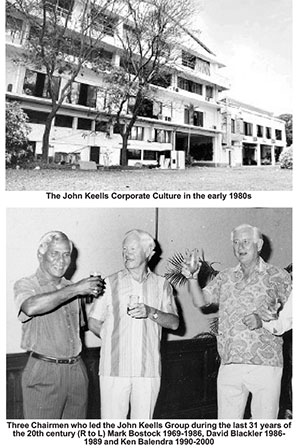
An Assignment in Hong Kong
In the midst of my busy schedule with HMMS, Bobby Adams entrusted me, on short notice, with a very special assignment in Hong Kong. He wanted me to quickly plan and organize a large Sri Lankan and Maldivian food festival at the Hotel Furama InterContinental, Hong Kong. It was an important, two-week tourism promotional festival, in partnership with a few organizations. They were represented by well-known leaders of the tourist industry, such as M. Y. M. Thahir of Walkers Tours, Pani Seneviratne of Ceylon Tourist Board and Ahamed Didi of Universal Resorts, The Maldives.
The InterContinental Hotel Group was expected to be represented by a senior Sous Chef from their five-star hotel in Colombo. The festival included 28 large buffets for lunch and dinner over 14 days, promoting Sri Lankan cuisine and a few dishes from the Maldives. The Hotel Furama InterContinental had agreed to provide three of their cooks to assist the Guest Executive Chef representing Sri Lanka.
At the eleventh hour, the Executive Chef of Hotel Ceylon InterContinental, who was a Swiss-German, had refused to release his second in command to travel to Hong Kong. He had been concerned that the support in Hong Kong was inadequate to produce 28 large buffets over 14 days. He wanted three Sri Lankan additional chefs from his brigade to be provided with air tickets to Hong Kong. That request was not accepted by Air Lanka, the airline sponsor of festival.
The reputation of Walkers Tours (a key subsidiary of John Keells Group) as the main organizer of the festival was at stake. Bobby asked me, “Chandi, we need someone like you to rise to the occasion. Can you please help our company by organizing all aspects of food for this festival in Hong Kong?” I planned the menus, calculated quantities of all ingredients and purchased a few key buffet decorations on the same day from Laksala, and took off on an Air Lanka flight to Hong Kong the very next day. Having ceased to be an Executive Chef, two years prior to that, it was a challenging assignment for me, but I always loved a challenge!
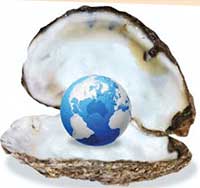
During the flight, I was thinking of my father’s advice given to me just before my trip. He said, “Chandana, try your best to do even a short trip to China after the food festival. Future global tourism will be divided into two – China and the rest of the world! Don’t miss this opportunity.” As a former state visitor to China in the 1950s and the author of the first-ever Sinhala book about China in the 1960s, my father had a deep knowledge about China’s past and the present. Therefore, I was not surprised by his prediction for the future, although in 1981, it was difficult to imagine how China would eventually become one of the four top tourist destinations in the world.
Features
The US-China rivalry and challenges facing the South
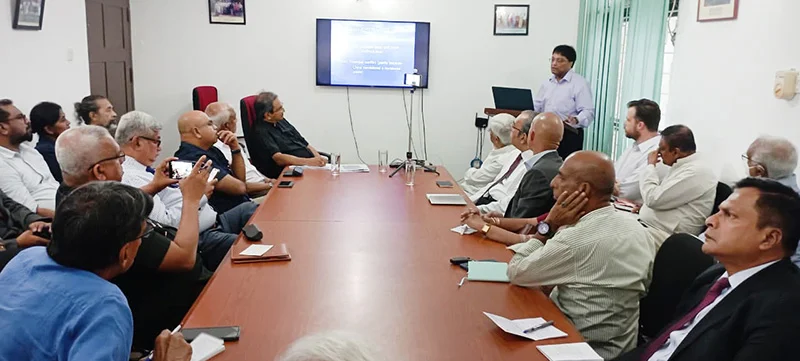
 The US-China rivalry could be said to make-up the ‘stuff and substance’ of world politics today but rarely does the international politics watcher and student of the global South in particular get the opportunity of having a balanced and comprehensive evaluation of this crucial relationship. But such a balanced assessment is vitally instrumental in making sense of current world power relations.
The US-China rivalry could be said to make-up the ‘stuff and substance’ of world politics today but rarely does the international politics watcher and student of the global South in particular get the opportunity of having a balanced and comprehensive evaluation of this crucial relationship. But such a balanced assessment is vitally instrumental in making sense of current world power relations.
Thanks to the Regional Centre for Strategic Studies (RCSS), Colombo the above window of opportunity was opened on December 8th for those sections of the public zealously pursuing an understanding of current issues in global politics. The knowledge came via a forum that was conducted at the RCSS titled, ‘The US-China Rivalry and Implications for the Indo-Pacific’, where Professor Neil DeVotta of the Wake Forest University of North Carolina in the US, featured as the speaker.
A widely representative audience was present at the forum, including senior public servants, the diplomatic corps, academics, heads of civil society organizations, senior armed forces personnel and the media. The event was ably managed by the Executive Director of the RCSS, retired ambassador Ravinatha Aryasinha. Following the main presentation a lively Q&A session followed, where many a point of interest was aired and discussed.
While there is no doubt that China is fast catching up with the US with regard to particularly military, economic, scientific and technological capability, Prof. DeVotta helped to balance this standard projection of ‘China’s steady rise’ by pointing to some vital facts about China, the omission of which would amount to the observer having a somewhat uninformed perception of global political realities.
The following are some of the facts about contemporary China that were highlighted by Prof. DeVotta:
* Money is steadily moving out of China and the latter’ s economy is slowing down. In fact the country is in a ‘ Middle Income Trap’. That is, it has reached middle income status but has failed to move to upper income status since then.
* People in marked numbers are moving out of China. It is perhaps little known that some Chinese are seeking to enter the US with a view to living there. The fact is that China’s population too is on the decline.
* Although the private sector is operative in China, there has been an increase in Parastatals; that is, commercial organizations run by the state are also very much in the fore. In fact private enterprises have begun to have ruling Communist Party cells in them.
* China is at its ‘peak power’ but this fact may compel it to act ‘aggressively’ in the international sphere. For instance, it may be compelled to invade Taiwan.
* A Hard Authoritarianism could be said to characterize central power in China today, whereas the expectation in some quarters is that it would shift to a Soft Authoritarian system, as is the case in Singapore.
* China’s influence in the West is greater than it has ever been.
The speaker was equally revelatory about the US today. Just a few of these observations are:
* The US is in a ‘Unipolar Moment’. That is, it is the world’s prime power. Such positions are usually not longstanding but in the case of the US this position has been enjoyed by it for quite a while.
* China is seen by the US as a ‘Revisionist Power’ as opposed to being a ‘Status Quo Power.’ That is China is for changing the world system slowly.
* The US in its latest national security strategy is paying little attention to Soft Power as opposed to Hard Power.
* In terms of this strategy the US would not allow any single country to dominate the Asia-Pacific region.
* The overall tone of this strategy is that the US should step back and allow regional powers to play a greater role in international politics.
* The strategy also holds that the US must improve economic ties with India, but there is very little mention of China in the plan.
Given these observations on the current international situation, a matter of the foremost importance for the economically weakest countries of the South is to figure out how best they could survive materially within it. Today there is no cohesive and vibrant collective organization that could work towards the best interests of the developing world and Dr. DeVotta was more or less correct when he said that the Non-alignment Movement (NAM) has declined.
However, this columnist is of the view that rather being a spent force, NAM was allowed to die out by the South. NAM as an idea could never become extinct as long as economic and material inequalities between North and South exist. Needless to say, this situation is remaining unchanged since the eighties when NAM allowed itself to be a non-entity so to speak in world affairs.
The majority of Southern countries did not do themselves any good by uncritically embracing the ‘market economy’ as a panacea for their ills. As has been proved, this growth paradigm only aggravated the South’s development ills, except for a few states within its fold.
Considering that the US would be preferring regional powers to play a more prominent role in the international economy and given the US’ preference to be a close ally of India, the weakest of the South need to look into the possibility of tying up closely with India and giving the latter a substantive role in advocating the South’s best interests in the councils of the world.
To enable this to happen the South needs to ‘get organized’ once again. The main differences between the past and the present with regard to Southern affairs is that in the past the South had outstanding leaders, such as Jawaharlal Nehru of India, who could doughtily stand up for it. As far as this columnist could ascertain, it is the lack of exceptional leaders that in the main led to the decline of NAM and other South-centred organizations.
Accordingly, an urgent task for the South is to enable the coming into being of exceptional leaders who could work untiringly towards the realization of its just needs, such as economic equity. Meanwhile, Southern countries would do well to, indeed, follow the principles of NAM and relate cordially with all the major powers so as to realizing their best interests.
Features
Sri Lanka and Global Climate Emergency: Lessons of Cyclone Ditwah
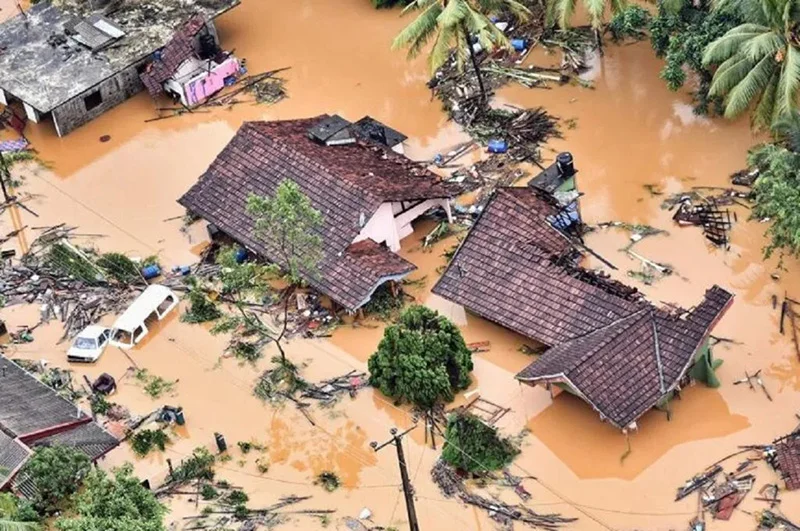
Tropical Cyclone Ditwah, which made landfall in Sri Lanka on 28 November 2025, is considered the country’s worst natural disaster since the deadly 2004 tsunami. It intensified the northeast monsoon, bringing torrential rainfall, massive flooding, and 215 severe landslides across seven districts. The cyclone left a trail of destruction, killing nearly 500 people, displacing over a million, destroying homes, roads, and railway lines, and disabling critical infrastructure including 4,000 transmission towers. Total economic losses are estimated at USD 6–7 billion—exceeding the country’s foreign reserves.
The Sri Lankan Armed Forces have led the relief efforts, aided by international partners including India and Pakistan. A Sri Lanka Air Force helicopter crashed in Wennappuwa, killing the pilot and injuring four others, while five Sri Lanka Navy personnel died in Chundikkulam in the north while widening waterways to mitigate flooding. The bravery and sacrifice of the Sri Lankan Armed Forces during this disaster—as in past disasters—continue to be held in high esteem by grateful Sri Lankans.
The Sri Lankan government, however, is facing intense criticism for its handling of Cyclone Ditwah, including failure to heed early warnings available since November 12, a slow and poorly coordinated response, and inadequate communication with the public. Systemic issues—underinvestment in disaster management, failure to activate protocols, bureaucratic neglect, and a lack of coordination among state institutions—are also blamed for avoidable deaths and destruction.
The causes of climate disasters such as Cyclone Ditwah go far beyond disaster preparedness. Faulty policymaking, mismanagement, and decades of unregulated economic development have eroded the island’s natural defenses. As climate scientist Dr. Thasun Amarasinghe notes:
“Sri Lankan wetlands—the nation’s most effective natural flood-control mechanism—have been bulldosed, filled, encroached upon, and sold. Many of these developments were approved despite warnings from environmental scientists, hydrologists, and even state institutions.”
Sri Lanka’s current vulnerabilities also stem from historical deforestation and plantation agriculture associated with colonial-era export development. Forest cover declined from 82% in 1881 to 70% in 1900, and to 54–50% by 1948, when British rule ended. It fell further to 44% in 1954 and to 16.5% by 2019.
Deforestation contributes an estimated 10–12% of global greenhouse gas emissions. Beyond removing a vital carbon sink, it damages water resources, increases runoff and erosion, and heightens flood and landslide risk. Soil-depleting monocrop agriculture further undermines traditional multi-crop systems that regenerate soil fertility, organic matter, and biodiversity.
In Sri Lanka’s Central Highlands, which were battered by Cyclone Ditwah, deforestation and unregulated construction had destabilised mountain slopes. Although high-risk zones prone to floods and landslides had long been identified, residents were not relocated, and construction and urbanisation continued unchecked.
Sri Lanka was the first country in Asia to adopt neoliberal economic policies. With the “Open Economy” reforms of 1977, a capitalist ideology equating human well-being with quantitative growth and material consumption became widespread. Development efforts were rushed, poorly supervised, and frequently approved without proper environmental assessment.
Privatisation and corporate deregulation weakened state oversight. The recent economic crisis and shrinking budgets further eroded environmental and social protections, including the maintenance of drainage networks, reservoirs, and early-warning systems. These forces have converged to make Sri Lanka a victim of a dual climate threat: gradual environmental collapse and sudden-onset disasters.
Sri Lanka: A Climate Victim
Sri Lanka’s carbon emissions remain relatively small but are rising. The impact of climate change on the island, however, is immense. Annual mean air temperature has increased significantly in recent decades (by 0.016 °C annually between 1961 and 1990). Sea-level rise has caused severe coastal erosion—0.30–0.35 meters per year—affecting nearly 55% of the shoreline. The 2004 tsunami demonstrated the extreme vulnerability of low-lying coastal plains to rising seas.
The Cyclone Ditwah catastrophe was neither wholly new nor surprising. In 2015, the Geneva-based Internal Displacement Monitoring Centre (IDMC) identified Sri Lanka as the South Asian country with the highest relative risk of disaster-related displacement: “For every million inhabitants, 15,000 are at risk of being displaced every year.”
IDMC also noted that in 2017 the country experienced seven disaster events—mainly floods and landslides—resulting in 135,000 new displacements and that Sri Lanka “is also at risk for slow-onset impacts such as soil degradation, saltwater intrusion, water scarcity, and crop failure”.
Sri Lanka ranked sixth among countries most affected by extreme weather events in 2018 (Germanwatch) and second in 2019 (Global Climate Risk Index). Given these warnings, Cyclone Ditwah should not have been a surprise. Scientists have repeatedly cautioned that warmer oceans fuel stronger cyclones and warmer air holds more moisture, leading to extreme rainfall. As the Ceylon Today editorial of December 1, 2025 also observed:
“…our monsoons are no longer predictable. Cyclones form faster, hit harder, and linger longer. Rainfall becomes erratic, intense, and destructive. This is not a coincidence; it is a pattern.”
Without urgent action, even more extreme weather events will threaten Sri Lanka’s habitability and physical survival.
A Global Crisis
Extreme weather events—droughts, wildfires, cyclones, and floods—are becoming the global norm. Up to 1.2 billion people could become “climate refugees” by 2050. Global warming is disrupting weather patterns, destabilising ecosystems, and posing severe risks to life on Earth. Indonesia and Thailand were struck by the rare and devastating Tropical Cyclone Senyar in late November 2025, occurring simultaneously with Cyclone Ditwah’s landfall in Sri Lanka.
More than 75% of global greenhouse gas emissions—and nearly 90% of carbon emissions—come from burning coal, oil, and gas, which supply about 80% of the world’s energy. Countries in the Global South, like Sri Lanka, which contribute least to greenhouse gas emissions, are among the most vulnerable to climate devastation. Yet wealthy nations and multilateral institutions, including the World Bank, continue to subsidise fossil fuel exploration and production. Global climate policymaking—including COP 30 in Belém, Brazil, in 2025—has been criticised as ineffectual and dominated by fossil fuel interests.
If the climate is not stabilised, long-term planetary forces beyond human control may be unleashed. Technology and markets are not inherently the problem; rather, the issue lies in the intentions guiding them. The techno-market worldview, which promotes the belief that well-being increases through limitless growth and consumption, has contributed to severe economic inequality and more frequent extreme weather events. The climate crisis, in turn, reflects a profound mismatch between the exponential expansion of a profit-driven global economy and the far slower evolution of human consciousness needed to uphold morality, compassion, generosity and wisdom.
Sri Lanka’s 2025–26 budget, adopted on November 14, 2025—just as Cyclone Ditwah loomed—promised subsidised land and electricity for companies establishing AI data centers in the country.
President Anura Kumara Dissanayake told Parliament: “Don’t come questioning us on why we are giving land this cheap; we have to make these sacrifices.”
Yet Sri Lanka is a highly water-stressed nation, and a growing body of international research shows that AI data centers consume massive amounts of water and electricity, contributing significantly to greenhouse gas emissions.
The failure of the narrow, competitive techno-market approach underscores the need for an ecological and collective framework capable of addressing the deeper roots of this existential crisis—both for Sri Lanka and the world.
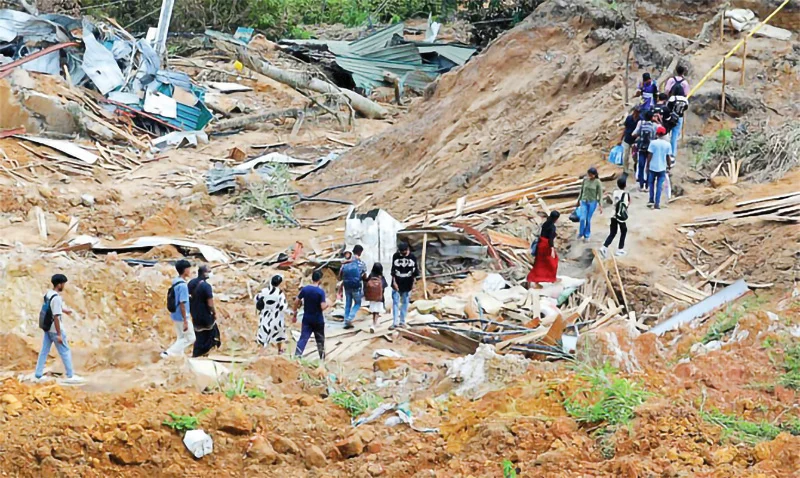
A landslide in Sri Lanka (AFP picture)
Ecological and Human Protection
Ecological consciousness demands
recognition that humanity is part of the Earth, not separate from it. Policies to address climate change must be grounded in this understanding, rather than in worldviews that prize infinite growth and technological dominance. Nature has primacy over human-created systems: the natural world does not depend on humanity, while humanity cannot survive without soil, water, air, sunlight, and the Earth’s essential life-support systems.
Although a climate victim today, Sri Lanka is also home to an ancient ecological civilization dating back to the arrival of the Buddhist monk Mahinda Thera in the 3rd century BCE. Upon meeting King Devanampiyatissa, who was out hunting in Mihintale, Mahinda Thera delivered one of the earliest recorded teachings on ecological interdependence and the duty of rulers to protect nature:
“O great King, the birds of the air and the beasts of the forest have as much right to live and move about in any part of this land as thou. The land belongs to the people and all living beings; thou art only its guardian.”
A stone inscription at Mihintale records that the king forbade the killing of animals and the destruction of trees. The Mihintale Wildlife Sanctuary is believed to be the world’s first.
Sri Lanka’s ancient dry-zone irrigation system—maintained over more than a millennium—stands as a marvel of sustainable development. Its network of interconnected reservoirs, canals, and sluices captured monsoon waters, irrigated fields, controlled floods, and even served as a defensive barrier. Floods occurred, but historical records show no disasters comparable in scale, severity, or frequency to those of today. Ancient rulers, including the legendary reservoir-builder King Parākramabāhu, and generations of rice farmers managed their environment with remarkable discipline and ecological wisdom.
The primacy of nature became especially evident when widespread power outages and the collapse of communication networks during Cyclone Ditwah forced people to rely on one another for survival. The disaster ignited spontaneous acts of compassion and solidarity across all communities—men and women, rich and poor, Buddhists, Christians, Muslims, and Hindus. Local and international efforts mobilized to rescue, shelter, feed, and emotionally support those affected. These actions demonstrated a profound human instinct for care and cooperation, often filling vacuums left by formal emergency systems.
Yet spontaneous solidarity alone is insufficient. Sri Lanka urgently needs policies on sustainable development, environmental protection, and climate resilience. These include strict, science-based regulation of construction; protection of forests and wetlands; proper maintenance of reservoirs; and climate-resilient infrastructure. Schools should teach environmental literacy that builds unity and solidarity, rather than controversial and divisive curriculum changes like the planned removal of history and introduction of contested modules on gender and sexuality.
If the IMF and international creditors—especially BlackRock, Sri Lanka’s largest sovereign bondholder, valued at USD 13 trillion—are genuinely concerned about the country’s suffering, could they not cancel at least some of Sri Lanka’s sovereign debt and support its rebuilding efforts? Addressing the climate emergency and the broader existential crisis facing Sri Lanka and the world ultimately requires an evolution in human consciousness guided by morality, compassion, generosity and wisdom. (Courtesy: IPS NEWS)
Dr Asoka Bandarage is the author of Colonialism in Sri Lanka: The Political Economy of the Kandyan Highlands, 1833-1886 (Mouton) Women, Population and Global Crisis: A Politico-Economic Analysis (Zed Books), The Separatist Conflict in Sri Lanka: Terrorism, Ethnicity, Political Economy, ( Routledge), Sustainability and Well-Being: The Middle Path to Environment, Society and the Economy (Palgrave MacMillan) Crisis in Sri Lanka and the World: Colonial and Neoliberal Origins, Ecological and Collective Alternatives (De Gruyter) and numerous other publications. She serves on the Advisory Boards of the Interfaith Moral Action on Climate and Critical Asian Studies.
Features
Cliff and Hank recreate golden era of ‘The Young Ones’

 Cliff Richard and Hank Marvin’s reunion concert at the Riverside Theatre in Perth, Australia, on 01 November, 2025, was a night to remember.
Cliff Richard and Hank Marvin’s reunion concert at the Riverside Theatre in Perth, Australia, on 01 November, 2025, was a night to remember.
The duo, who first performed together in the 1950s as part of The Shadows, brought the house down with their classic hits and effortless chemistry.
The concert, part of Cliff’s ‘Can’t Stop Me Now’ tour, featured iconic songs like ‘Summer Holiday’, ‘The Young Ones’, ‘Bachelor Boy’, ‘Living Doll’ and a powerful rendition of ‘Mistletoe and Wine.’
Cliff, 85, and Hank, with his signature red Fender Stratocaster, proved that their music and friendship are timeless.
According to reports, the moment the lights dimmed and the first chords of ‘Move It’ rang out, the crowd knew they were in for something extraordinary.
Backed by a full band, and surrounded by dazzling visuals, Cliff strode onto the stage in immaculate form – energetic and confident – and when Hank Marvin joined him mid-set, guitar in hand, the audience erupted in applause that shook the hall.
Together they launched into ‘The Young Ones’, their timeless 1961 hit which brought the crowd to its feet, with many in attendance moved to tears.
The audience was treated to a journey through time, with vintage film clips and state-of-the-art visuals adding to the nostalgic atmosphere.
Highlights of the evening included Cliff’s powerful vocals, Hank’s distinctive guitar riffs, and their playful banter on stage.
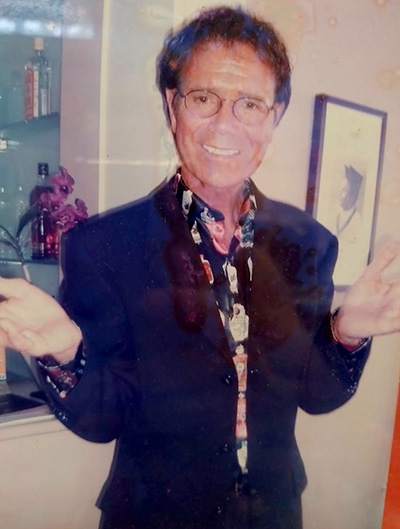
Cliff posing for The Island photographer … February,
2007
Cliff paused between songs to reflect on their shared journey saying:
“It’s been a lifetime of songs, memories, and friendship. Hank and I started this adventure when we were just boys — and look at us now, still up here making noise!”
As the final chords of ‘Congratulations’ filled the theatre, the crowd rose for a thunderous standing ovation that lasted several minutes.
Cliff waved, Hank gave a humble bow, and, together, they left the stage, arm-in-arm, to the refrain of “We’re the young ones — and we always will be.”
Reviews of the show were glowing, with fans and critics alike praising the duo’s energy, camaraderie, and enduring talent.
Overall, the Cliff Richard and Hank Marvin reunion concert was a truly special experience, celebrating the music and friendship that has captivated audiences for decades.
When Cliff Richard visited Sri Lanka, in February, 2007, I was invited to meet him, in his suite, at a hotel, in Colombo, and I presented him with my music page, which carried his story, and he was impressed.
In return, he personally autographed a souvenir for me … that was Cliff Richard, a truly wonderful human being.
-

 News3 days ago
News3 days agoOver 35,000 drug offenders nabbed in 36 days
-
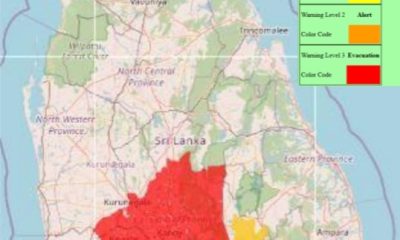
 News7 days ago
News7 days agoLevel III landslide early warning continue to be in force in the districts of Kandy, Kegalle, Kurunegala and Matale
-

 Business5 days ago
Business5 days agoLOLC Finance Factoring powers business growth
-
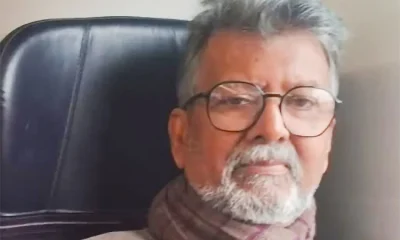
 News2 days ago
News2 days agoCyclone Ditwah leaves Sri Lanka’s biodiversity in ruins: Top scientist warns of unseen ecological disaster
-

 News5 days ago
News5 days agoCPC delegation meets JVP for talks on disaster response
-

 News5 days ago
News5 days agoA 6th Year Accolade: The Eternal Opulence of My Fair Lady
-
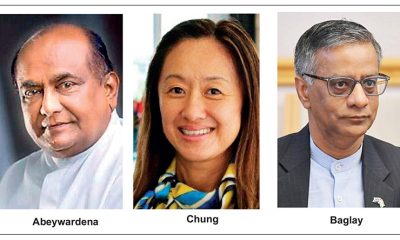
 Features1 day ago
Features1 day agoFinally, Mahinda Yapa sets the record straight
-

 News3 days ago
News3 days agoRising water level in Malwathu Oya triggers alert in Thanthirimale

